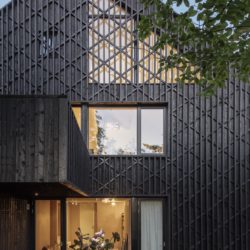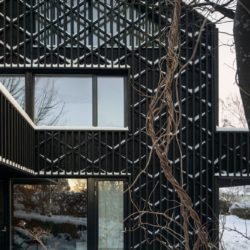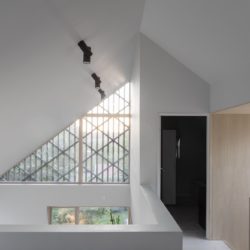
On a southwest-facing slope by the sea stands Villa Timmerman, a semi-detached house designed by the married architect couple Andreas Lyckefors and Josefine Wikholm.
Askim, in the south of Gothenburg, is a popular residential suburb which has been gradually densified since the 1960s and is today almost completely developed. Here, the architects bought a plot of land for residential use and then built a semi-detached house under their own auspices, where the other part of the house partially financed the project.
SITUATION
Andreas: It was a challenge to create a semi-detached house with equal qualities in both ends as they naturally face different directions. We had to study the local conditions carefully and take into account weather conditions, views, sun, evening sun, contact with the street and neighbors. In the end the house could be arranged so that both parts of the house get morning-, noon- and evening sun. There is always sun on one terrace or balcony during the bright part of the day.
Another challenge was to create qualities on all floors as the house is placed in a slope. The flow of light through the structure helped sculpting the plan and placement openings. The stairs at the back of the house, with large windows and glass roofs, allow a good amount of light deep into the ground floor and balance the large glass sections on the mezzanine level. The result is that light comes from three directions also at ground level. Ceiling lights and double ceiling height help to create a home where the light flows even on cloudy days.
By working with these qualities, the two houses can thus be experienced as independent parts, in a close relationship with the landscape and with flowing light and open spaces, rather than as a semi-detached house on a hillside plot.
ORGANISATION
We wanted the house to be able to grow with the family and function well during all stages of life. With proximity to the children during the toddler years, more private for the teenage family and with a home office or a lodger for the family with adult children. By breaking up the conventional function-separated room plan, the floor plan can be given consistent qualities. The social room runs throughout the house, bedrooms and toilets are placed on all floors. The small children can sleep close to their parents while older children, teenagers or guests can live on their own floor with toilet and their own living room.
MATERIAL
The house is built entirely of wood, with a pre-fabricated frame that was mounted on site. The dark wooden facade has been treated with wood tar, in a mixture of black and brown pigment. The origin of the specific shade was a desire for a warmer black color that was rich in pigment and that could be experienced differently in different lights.
On the outside of the wood cladding are three grids of diagonal and vertical ribs. The grid was an experiment that proved to work well as extra protection against solar radiation on the façade and as a protective layer against the drifting rain on the west coast.
The roof is a combination of tarred wood panel and solar cells. Here, the solar panels have been seamlessly integrated into the wooden roof, thanks to a carefully studied detail. The large internal staircase is built of ash wood with veneer on the walls cross laminated steps, carriage, intermediate landing and railing. The levels in the stairs form small spaces and also function as site-built sofas.
_
Project name: Villa Timmerman
Location: Askim, Gothenburg, Sweden
Year: 2018-2020
Status: Completed
Type: Semi-detached house
Client: Private
Size: 2 x 179 m2
Team: Andreas Lyckefors & Josefine Wikholm
Contractor: BoArt Svenska Designhem













































